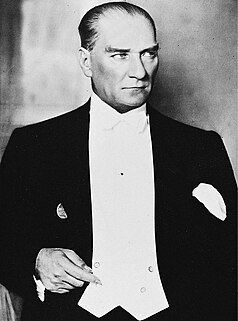 W
WKemal Atatürk was a Turkish field marshal, revolutionary statesman, author, and the founding father of the Republic of Turkey, serving as its first president from 1923 until his death in 1938. He undertook sweeping progressive reforms, which modernized Turkey into a secular, industrial nation. Ideologically a secularist and nationalist, his policies and theories became known as Kemalism. Due to his military and political accomplishments, Atatürk is regarded as one of the most important political leaders of the 20th century.
 W
WÜlkü Adatepe was the youngest adopted daughter of Mustafa Kemal Atatürk. Her interactions with Atatürk were often featured in Turkish media, contributing to the depiction of Atatürk as the "father of Turks" For example, the cover of the Alfabe textbook featured Ülkü studying with Atatürk.
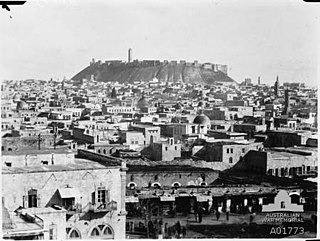 W
WThe Battle of Aleppo was fought on 25 October 1918, when Prince Feisal's Sherifial Forces captured the city during the Pursuit to Haritan from Damascus, in the last days of the Sinai and Palestine Campaign in the First World War.
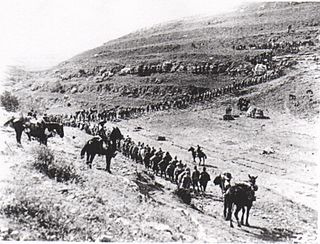 W
WThe First Transjordan attack on Amman and to their enemy as the First Battle of the Jordan took place between 21 March and 2 April 1918, as a consequence of the successful Battle of Tell 'Asur which occurred after the Capture of Jericho in February and the Occupation of the Jordan Valley began, during the Sinai and Palestine Campaign of World War I. During the First Transjordan attack large incursions into Ottoman territory occurred. Firstly the Passage of the Jordan River, was successfully captured between 21 and 23 March, followed by the first occupation of Es Salt in the hills of Moab between 24 and 25 March. The First Battle of Amman took place between 27 and 31 March when the Anzac Mounted Division and the Imperial Camel Corps Brigade were reinforced by two battalions of 181st Brigade followed by a second two battalions from the 180th Brigade and artillery. The Fourth Army headquarters located in Amman was strongly garrisoned and during the battle received reinforcements on the Hejaz railway, the strength of which eventually forced the attacking force to retire back to the Jordan Valley between 31 March and 2 April. The Jordan Valley would continue to be occupied by the Egyptian Expeditionary Force (EEF) through the summer until the middle of September 1918 when the Battle of Megiddo began.
 W
WThe First Battle of Amman was fought from 27 to 31 March 1918 during the First Transjordan attack on Amman of the Sinai and Palestine Campaign of the First World War. The 60th (London) Division and the Anzac Mounted Division attacked the Ottoman garrison at Amman deep in enemy occupied territory, 48 kilometres (30 mi) from their front line, after capturing Es Salt and Shunet Nimrin. The Egyptian Expeditionary Force (EEF) was successfully counterattacked by Ottoman Empire forces forcing them to retreat back to the bridgeheads captured on the Jordan River.
 W
WA plot to assassinate the 1st President of Turkey Mustafa Kemal Pasha on 14 June 1926 in İzmir was developed by a group of people, including ex-ministers, lawmakers and governors, but was prevented without being implemented. The assassination attempt has also been referred to as the İzmir Conspiracy and İzmir Assassination.
 W
WMakbule Atadan was the sister of Mustafa Kemal Atatürk, the founder of the Republic of Turkey. She was the only one surviving sister of Atatürk, while the other four siblings died at early ages.
 W
WAtatürk Cultural Center, also simply called AKM, is a cultural center in Istanbul. As the focal point of Taksim Square, it is not only a multi-purpose cultural center and opera house, but an icon of Istanbul. The AKM is considered an important example of Turkish architecture from the 1960s.
 W
WThe Atatürk Dam, originally the Karababa Dam, is a zoned rock-fill dam with a central core on the Euphrates River on the border of Adıyaman Province and Şanlıurfa Province in the Southeastern Anatolia Region of Turkey. Built both to generate electricity and to irrigate the plains in the region, it was renamed in honour of Mustafa Kemal Atatürk (1881–1938), the founder of the Turkish Republic. The construction began in 1983 and was completed in 1990. The dam and the hydroelectric power plant, which went into service after the upfilling of the reservoir was completed in 1992, are operated by the State Hydraulic Works (DSİ). The reservoir created behind the dam, called Lake Atatürk Dam, is the third largest in Turkey.
 W
WThe Atatürk Olympic Stadium is a stadium in Istanbul, Turkey. Located in the western district of İkitelli, it is the largest-capacity stadium in the country. The stadium is named after Mustafa Kemal Atatürk, the founder and first President of the Republic of Turkey. Its construction began in 1999 and was completed in 2002. It was originally built for Turkey's failed bid for the 2008 Olympic Games that were ultimately awarded to Beijing, China. It cost about US$140 million.
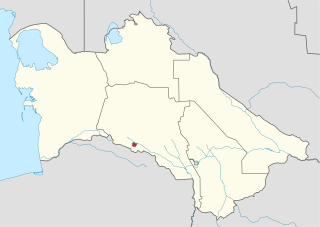 W
WAtatürk Square is a park named after Mustafa Kemal Atatürk, founder of the Turkish Republic located in the center of Ashgabat.
 W
WAtatürk University is a land-grant university established in 1957 in Erzurum, Turkey. The university consists of 23 faculties, 18 colleges, 8 institutes and 30 research centers. Atatürk University's main campus is in Erzurum city, Eastern Anatolia's largest city. It is now one of the city's most significant resources. Since its establishment in 1957, it has served as a hub of educational and cultural excellence for the eastern region.
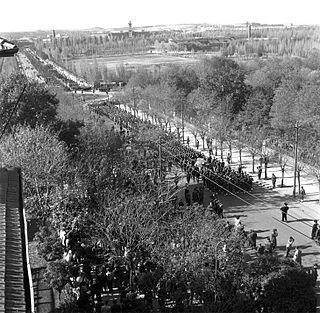 W
WMustafa Kemal Atatürk, first President of the Republic of Turkey, died at the Dolmabahçe Palace, his official residence in Istanbul, on 10 November 1938. His state funeral was held in the capital city of Ankara on 21 November, and was attended by dignitaries from seventeen nations. His body remained at the Ethnography Museum of Ankara until 10 November 1953, the fifteenth anniversary of his death, when his remains were carried to his final resting place at Anıtkabir.
 W
WAtatürk's cult of personality was started by Mustafa Kemal Atatürk's successors after his death in 1938, by members of both his Republican People's Party and opposition parties alike, and in a limited amount by himself during his lifetime in order to popularize and cement his social and political reforms as a founder and the first President of Turkey. It has been described as the "world's longest-running personality cult".
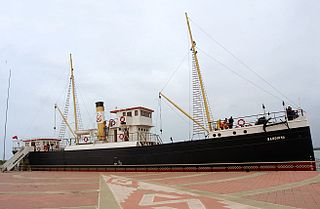 W
WSS Bandırma was an Ottoman mixed-freight ship, which became famous for her historical role in taking Mustafa Kemal Pasha (Atatürk) from Constantinople (today-Istanbul) to Samsun in May 1919 that marked the establishment of the Turkish national movement.
 W
WThe Battle of Dumlupınar, or known as Field Battle of the Commander-in-Chief in Turkey, was the last battle in the Greco-Turkish War (1919–1922). The battle was fought from 26 to 30 August 1922 near Dumlupınar, Kütahya in Turkey.
 W
WThe Battle of Sakarya, also known as the Battle of the Sangarios, was an important engagement in the Greco-Turkish War (1919–1922), the western front of the Turkish War of Independence.
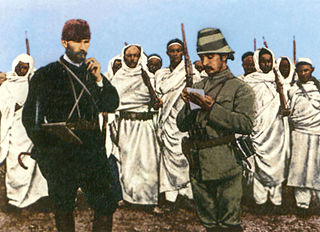 W
WBattle of Tobruk (1911) or Nadura Hill Battle was a small engagement in the Italo-Turkish War. It is mostly known for the involvement and leadership of future Turkish president Mustafa Kemal.
 W
WThe Battle of Chunuk Bair was a World War I battle fought between the Ottoman defenders and troops of the British Empire over control of the peak in August 1915. The capture of Chunuk Bair,, the secondary peak of the Sari Bair range, was one of the two objectives of the Battle of Sari Bair.
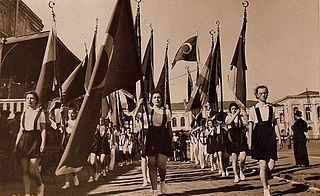 W
WThe Commemoration of Atatürk, Youth and Sports Day, is an annual Turkish national holiday celebrated on May 19 to commemorate Mustafa Kemal's landing at Samsun on May 19, 1919, which is regarded as the beginning of the Turkish War of Independence in the official historiography.
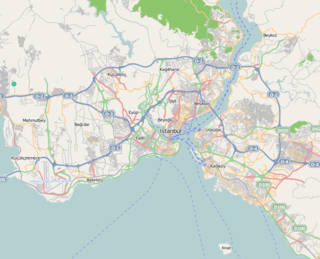 W
WDolmabahçe Palace located in the Beşiktaş district of Istanbul, Turkey, on the European coast of the Bosporus strait, served as the main administrative center of the Ottoman Empire from 1856 to 1887 and from 1909 to 1922.
 W
WAli Rıza Efendi (1839–1888) was the father of Mustafa Kemal Atatürk and the husband of Zübeyde Hanım.
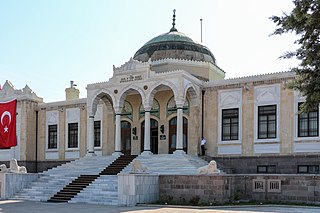 W
WThe Ethnography Museum of Ankara is dedicated to the cultures of Turkic civilizations. The building was designed by architect Arif Hikmet Koyunoğlu and was built between 1925 and 1928. The museum temporarily hosted the sarcophagus of Mustafa Kemal Atatürk from 1938 to 1953, during the period of the construction of Anıtkabir, his final resting place.
 W
WFikriye Hanım, posthumously Zeynep Fikriye Özdinçer, was a Turkish woman. She was a relative of Mustafa Kemal Atatürk and his girlfriend. Her death remained mysterious.
 W
WGazi University is a public university primarily located in Ankara, Turkey. It was established in 1926 by Mustafa Kemal Atatürk as Gazi Teacher Training Institute. In 1982, it was reorganized by merging with the Bolu Academy of Engineering and Architecture, Ankara Academy of Economics and Commercial Sciences, the Ankara College of Technical Careers, the Ankara Girls' College of Technical Careers, and the Ankara State Academy of Engineering and Architecture to become a large metropolitan university as part of the act which created the Board of Higher Education. Prior to 1982 when the Board of Higher Education Law came into effect, institutes of higher education in Turkey were organized under different structures as universities, academies, institutes, and schools. In 1992 faculties and vocational schools in Bolu became Abant Izzet Baysal University.
 W
WSabiha Gökçen was a Turkish aviator. During her flight career, she flew around 8,000 hours and participated in 32 different military operations. She was the world's first female fighter pilot, aged 23. Others such as Marie Marvingt and Evgeniya Shakhovskaya preceded her as military pilots in other roles, but not as fighter pilots and without military academy enrollment. She was an orphan, and one of the thirteen adopted children of Mustafa Kemal Atatürk.
 W
WMustafa Kemal University, abbreviated as MKU, is a public university established 1992 at Antakya, Hatay Province in southern Turkey. It is named after the founder of the Turkish Republic, Mustafa Kemal Atatürk.
 W
WAyşe Afet İnan was a Turkish historian and sociologist. She was one of the eight adopted daughters of Mustafa Kemal Atatürk. She was known to be involved in the practice of physical anthropology, as she measured over sixty thousands skulls in Anatolia, which was aimed to support the Turkish History Thesis.
 W
WThe Italo-Turkish or Turco-Italian War was fought between the Kingdom of Italy and the Ottoman Empire from September 29, 1911, to October 18, 1912. As a result of this conflict, Italy captured the Ottoman Tripolitania Vilayet (province), of which the main sub-provinces (sanjaks) were Fezzan, Cyrenaica, and Tripoli itself. These territories became the colonies of Italian Tripolitania and Cyrenaica, which would later merge into Italian Libya.
 W
WThe Capture of Jenin occurred on 20 September 1918, during the Battle of Sharon which together with the Battle of Nablus formed the set piece Battle of Megiddo fought between 19 and 25 September during the last months of the Sinai and Palestine Campaign of the First World War. During the cavalry phase of the Battle of Sharon carried out by the Desert Mounted Corps, the 3rd Light Horse Brigade, Australian Mounted Division attacked and captured the town of Jenin located on the southern edge of the Esdraelon Plain 40–50 miles (64–80 km) behind the front line in the Judean Hills. The Australian light horse captured about 2,000 prisoners, the main supply base and the ordnance depot of the Seventh and the Eighth Armies in and near the town. They also cut the main road from Nablus and a further 6,000 Ottoman Empire and German Empire prisoners, were subsequently captured as they attempted to retreat away from the Judean Hills.
 W
WThe Capture of Jisr ed Damieh took place on 22 September 1918 during the Third Transjordan attack of the Battle of Nablus which, along with the main Battle of Sharon formed the Battle of Megiddo fought during the Sinai and Palestine Campaign of the First World War. Units of Chaytor's Force under the commanded by Brigadier-General William Meldrum, and known as "Meldrum's Force", attacked and captured the bridge. This successful attack cut the most direct line of retreat from the Judean Hills for the Seventh and remnants of the Eighth Armies, while units from these two armies were moving towards, and crossing the Jisr ed Damieh bridge over the Jordan River. This victory by Meldrum's Force opened the way for Chaytor's Force to advance along the main Nablus to Es Salt road to capture Es Salt and to continue on to the victory at the Second Battle of Amman.
 W
WKemalism, also known as Atatürkism, or the Six Arrows, is the founding ideology of the Republic of Turkey. Kemalism, as it was implemented by Mustafa Kemal Atatürk, was defined by sweeping political, social, cultural and religious reforms designed to separate the new Turkish state from its Ottoman predecessor and embrace a modernized lifestyle, including the establishment of democracy, secularism, and state support of the sciences and free education, many of which were first introduced to Turkey during Atatürk's presidency in his reforms.
 W
WThe Charge at Khan Ayash occurred on 2 October 1918 about 17 miles (27 km) north of Damascus after the pursuit to, and capture of Damascus, which followed the decisive Egyptian Expeditionary Force victory at the Battle of Megiddo on 25 September during the Sinai and Palestine Campaign of World War I. After Damascus had been encircled by Desert Mounted Corps on 30 September, the 3rd Light Horse Brigade advanced through the city on 1 October to charge and capture remnants of the Ottoman Yildirim Army Group withdrawing along the road north to Rayak and Homs.
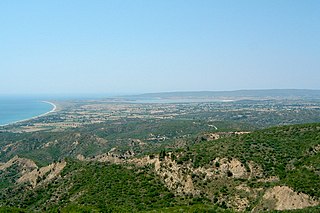 W
WThe landing at Suvla Bay was an amphibious landing made at Suvla on the Aegean coast of the Gallipoli peninsula in the Ottoman Empire as part of the August Offensive, the final British attempt to break the deadlock of the Battle of Gallipoli. The landing, which commenced on the night of 6 August 1915, was intended to support a breakout from the ANZAC sector, five miles (8 km) to the south.
 W
WThe Battle of Megiddo also known in Turkish as the Nablus Hezimeti, or the Nablus Yarması was fought between 19 and 25 September 1918, on the Plain of Sharon, in front of Tulkarm, Tabsor and Arara in the Judean Hills as well as on the Esdralon Plain at Nazareth, Afulah, Beisan, Jenin and Samakh. Its name, which has been described as "perhaps misleading" since very limited fighting took place near Tel Megiddo, was chosen by Allenby for its biblical and symbolic resonance.
 W
WMustafa Kemal Atatürk was a field marshal, revolutionary statesman, and founder of the Republic of Turkey as well as its first President. Mustafa Kemal Atatürk's military career explains his life between graduation from Ottoman War College in Istanbul as a lieutenant in 1905 to his resignation from the Ottoman Army on 8 July 1919, as well as his military leadership throughout the subsequent Turkish War of Independence.
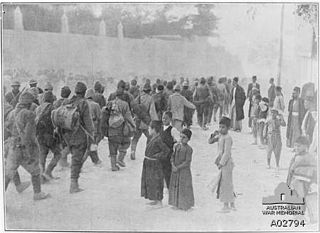 W
WThe Battle of Nablus took place, together with the Battle of Sharon during the set piece Battle of Megiddo between 19 and 25 September 1918 in the last months of the Sinai and Palestine Campaign of the First World War. Fighting took place in the Judean Hills where the British Empire's XX Corps attacked the Ottoman Empire's Yildirim Army Group's Seventh Army defending their line in front of Nablus. This battle was also fought on the right flank in the Jordan Valley, where Chaytor's Force attacked and captured the Jordan River crossings, before attacking the Fourth Army at Es Salt and Amman capturing many thousands of prisoners and extensive territory. The Battle of Nablus began half a day after the main Battle of Sharon, which was fought on the Mediterranean section of the front line where the XXI Corps attacked the Eighth Army defending the line in front of Tulkarm and Tabsor and the Desert Mounted Corps which rode north to capture the Esdrealon Plain. Together these two battles, known as the Battle of Megiddo, began the Final Offensive of the war in the Sinai and Palestine campaign.
 W
WThe Battle of Nazareth began on 20 September 1918, during the Battle of Sharon, which together with the Battle of Nablus formed the set piece Battle of Megiddo fought during the last months of the Sinai and Palestine Campaign of the First World War. During the cavalry phase of the Battle of Sharon the Desert Mounted Corps rode to the Esdraelon Plain 40 and 50 miles behind the front line in the Judean Hills. At Nazareth on the plain, the 13th Cavalry Brigade of the 5th Cavalry Division attempted to capture the town and the headquarters of the Yildirim Army Group which was eventually captured the following day after the garrison had withdrawn.
 W
WNe mutlu Türküm diyene! is a motto of the Republic of Turkey. Mustafa Kemal Atatürk used this phrase in his speech delivered for the 10th Anniversary of the Republic of Turkey, on October 29, 1933 for the first time. In 1972, the Turkish Ministry of National Education added this phrase to the Student Oath. This was annulled by the AKP government in 2013.
 W
WNutuk was a speech delivered by Mustafa Kemal Atatürk from 15 to 20 October 1927, at the second congress of Cumhuriyet Halk Partisi. The speech covered the events between the start of the Turkish War of Independence on 19 May 1919, and the foundation of the Republic of Turkey, in 1923. It took thirty-six hours to be read by Atatürk, and became a foundation of Kemalist historiography.
 W
WThe one-party period of the Republic of Turkey began with the formal establishment of the country in 1923. The Republican People's Party (CHP) was the only party between 1923 and 1945, when the National Development Party was established. After winning the first multiparty elections in 1946 by a landslide, the Republican People's Party lost the majority to the Democratic Party in the 1950 elections. During the single-party period, President Mustafa Kemal Atatürk repeatedly requested that opposition parties be established against the Republican People's Party in order to transition into multi-party democracy; in 1930, the Liberal Republican Party was established but dissolved by its founder. The Progressive Republican Party had also been established in 1924 by Kâzım Karabekir, but was banned after its members' involvement in the 1925 Sheikh Said rebellion. Despite Atatürk's efforts in establishing a self-propagating multi-party system during his presidency, this was only established after his death in 1938.
 W
WThe Stalemate in Southern Palestine was a six month standoff between the British Egyptian Expeditionary Force (EEF) and the Ottoman Army in World War I. The two hostile forces faced each other along the Gaza to Beersheba line during the Sinai and Palestine Campaign, with neither side able to force its opponent to withdraw. The stalemate began in April 1917 with the defeat of the EEF by the Ottoman Army at the Second Battle of Gaza and lasted until the EEF offensive began with the Battle of Beersheba on 31 October 1917.
 W
WIn Turkish, the phrase "Yurtta sulh, cihanda sulh" - "Peace at Home, Peace in the World" - was first pronounced by Mustafa Kemal Atatürk on 20 April 1931 to the public during his tours of Anatolia. This stance was later integrated and implemented as the foreign policy of the Republic of Turkey.
 W
WMustafa Kemal Atatürk founded the Republic of Turkey, and served as its president from 1923 until his death in 1938. His personal life has been the subject of numerous studies. According to Turkish historian Kemal H. Karpat, Atatürk's recent bibliography included 7,010 different sources. Atatürk's personal life has its controversies, ranging from where he was born to his correct full name. The details of his marriage have always been a subject of debate. His religious beliefs were discussed in Turkish political life as recently as the Republic Protests during the 2007 presidential election.
 W
WThe Republic Monument is a notable monument located at Taksim Square in Istanbul, Turkey, to commemorate the formation of the Turkish Republic in 1923.
 W
WThe Battle of Samakh was fought on 25 September 1918, during the Battle of Sharon which together with the Battle of Nablus formed the set piece Battle of Megiddo fought from 19 to 25 September 1918, in the last months of the Sinai and Palestine Campaign of the First World War. During the cavalry phase of the Battle of Sharon the Desert Mounted Corps commanded by the Australian Lieutenant General Harry Chauvel, captured the Esdraelon Plain 40–50 miles (64–80 km) behind the front line in the Judean Hills on 20 September, when the 3rd Light Horse Brigade captured Jenin. The 4th Light Horse Brigade, Australian Mounted Division was deployed guarding supply columns, and prisoners, before being ordered to attack and capture Samakh on the shore of the Sea of Gallilee. Here the Ottoman and German garrison had been ordered by the commander of the Yildirim Army Group to fight to the last man.
 W
WThe MV Savarona is the presidential yacht of the Republic of Turkey. She was the largest in the world when launched February 28, 1931, and remains, with a length of 136 m (446 ft), one of the world’s longest. Although owned by the government of Turkey, she had been briefly leased out to Turkish businessman Kahraman Sadıkoğlu. However, upon orders of the Turkish Government her lease was terminated and she reverted to the Turkish State. The first time she was used again for an official reception was in March 2015.
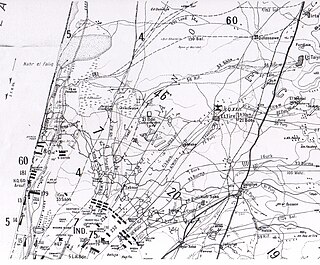 W
WThe Battle of Sharon fought between 19 and 25 September 1918, began the set piece Battle of Megiddo half a day before the Battle of Nablus, in which large formations engaged and responded to movements by the opposition, according to pre-existing plans, in the last months of the Sinai and Palestine Campaign of World War I. The fighting took place over a wide area from the Mediterranean Sea east to the Rafat salient in the Judean Hills. Here the Egyptian Expeditionary Force (EEF) XXI Corps with the French brigade sized Détachement Français de Palestine et de Syrie attacked the Yildirim Army Group Eighth Army's XXII Corps and German Asia Corps. The Battle of Sharon extended well behind the Ottoman front lines when the Desert Mounted Corps rode through a gap in the front line across the Plain of Sharon to occupy the Esdraelon Plain. Meanwhile, during the Battle of Nablus the XX Corps attacked Nablus while Chaytor's Force held the right flank in the Jordan Valley before advancing to secure bridges and fords across the Jordan River, to continue the encirclement the defenders in the Judean Hills. Subsequently, Chaytor's Force advanced against the Fourth Army to capture Es Salt and Amman after the Second Battle of Amman.
 W
WThe Charge at Sheria took place on 7 November 1917 during the Battle of Hareira and Sheria when the 11th and 12th Light Horse Regiments charged a Yildirim Army Group rearguard in support of an attack by the 60th (London) Division during the Southern Palestine Offensive of the Sinai and Palestine Campaign in World War I.
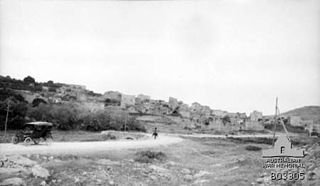 W
WThe Battle of Tabsor was fought on 19–20 September 1918 beginning the Battle of Sharon, which along with the Battle of Nablus formed the set piece Battle of Megiddo fought between 19 and 25 September in the last months of the Sinai and Palestine Campaign of the First World War. During the infantry phase of the Battle of Sharon the British Empire 60th Division, XXI Corps attacked and captured the section of the front line nearest the Mediterranean coast under cover of an intense artillery barrage including a creeping barrage and naval gunfire. This Egyptian Expeditionary Force (EEF) victory over the entrenched Ottoman Eighth Army, composed of German and Ottoman soldiers, began the Final Offensive, ultimately resulting in the destruction of the equivalent of one Ottoman army, the retreat of what remained of two others, and the capture of many thousands of prisoners and many miles of territory from the Judean Hills to the border of modern-day Turkey. After the end of the battle of Megiddo, the Desert Mounted Corps pursued the retreating soldiers to Damascus, six days later. By the time the Armistice of Mudros was signed between the Allies and the Ottoman Empire five weeks later, Aleppo had been captured.
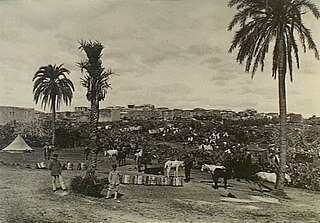 W
WThe Battle of Tulkarm took place on 19 September 1918, beginning of the Battle of Sharon, which along with the Battle of Nablus formed the set piece Battle of Megiddo fought between 19 and 25 September in the last months of the Sinai and Palestine Campaign of the First World War. During the infantry phase of the Battle of Sharon the British Empire 60th Division, XXI Corps attacked and captured the section of the front line nearest the Mediterranean coast under cover of an intense artillery barrage including a creeping barrage and naval gunfire. This Egyptian Expeditionary Force (EEF) victory over the entrenched Ottoman Eighth Army, composed of German and Ottoman soldiers, began the Final Offensive, ultimately resulting in the destruction of the equivalent of one Ottoman army, the retreat of what remained of two others, and the capture of many thousands of prisoners and many miles of territory from the Judean Hills to the border of modern-day Turkey. After the end of the battle of Megiddo, the Desert Mounted Corps pursued the retreating soldiers to Damascus, six days later. By the time an Armistice of Mudros was signed between the Allies and the Ottoman Empire five weeks later, Aleppo had been captured.
 W
WThe Turkish Historical Society also known as Turkish Historical Association or Turkish History Foundation is a research society studying the history of Turkey and the Turkish people, founded in 1931 by the initiative of Mustafa Kemal Atatürk, with headquarters in Ankara, Turkey. It has been described as "the Kemalist official producer of nationalist historical narratives".
 W
WThe Turkish Language Association is the official regulatory body of the Turkish language, founded on July 12, 1932 by the initiative of Atatürk and headquartered in Ankara, Turkey. The Institution acts as the official authority on the language, contributes to linguistic research on Turkish and other Turkic languages, and is charged with publishing the official dictionary of the language, Güncel Türkçe Sözlük.
 W
WLatife Uşaklıgil was Mustafa Kemal Pasha's wife between 1923 and 1925. She was related from her father's side to Turkish novelist Halid Ziya Uşaklıgil.
 W
WVatan ve Hürriyet was a small, secret revolutionary society of reformist officers opposed to the autocratic regime of Ottoman sultan Abdul Hamid II in the early 20th century. It was started by Mustafa Cantekin while in exile in Syria. The future founder of the Republic of Turkey, Mustafa Kemal Atatürk, joined the group in 1905 as a young lieutenant in the Ottoman army in Damascus.
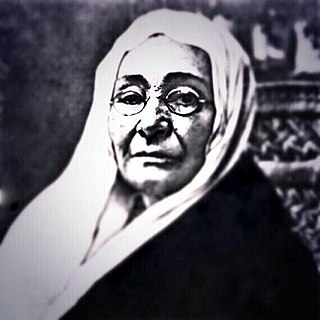 W
WZübeyde Hanım was the mother of Mustafa Kemal Atatürk, the founder of the Republic of Turkey. She was the only daughter of the Hacısofular family which included her two brothers. Zübeyde was born in Langaza village, Ottoman Empire in 1857 as the daughter of a Turkish peasant. Hacısofular Family migrated to Macedonia after the collapse of Karamanids.